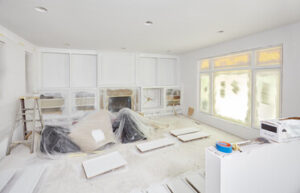A fresh coat of paint can refresh your home, open up new design possibilities, and help you get the look you want. But before your professional Wilmington Painter arrives, it’s important to prep the area.
That includes removing or covering furniture, putting away any photos or wall hangings, and taking other steps to ensure a smooth painting process.

Clear And Protect The Area
Whether you’re painting your own home or hiring professional painters, clearing and protecting the area is one of the most important steps to take. You don’t want your belongings to be damaged by splatters or dust while the work is being done.
For example, it’s a good idea to remove rugs from rooms that are being painted and put them in a garage or other storage space for the duration of the project. This will prevent scuffs and stains on the floors. It’s also a good idea to move furniture away from walls or push it to the center of the room so that it isn’t in harm’s way. If you have doors that open into the room, you should add a doorstop to keep them from swinging into the walls and damaging them.
If there are any breakable or irreplaceable items that you can’t move, cover them with blankets or canvas drop cloths to protect them from splatters and dust. You should also remove light switches and outlet covers in rooms that are being painted, as well as any decorative features like mirrors or clocks. This will help ensure that your heirlooms are safe during the painting process. If you have outdoor furniture or planters, it’s a good idea to move them or cover them with canvas or plastic sheeting to prevent paint from dripping on them.
Clean The Surfaces
When it comes to prepping your home for painting, cleaning is one of the most important steps. It’s not just about dusting surfaces, but actually getting rid of old paint and sanding down any rough areas before you begin applying new coats of paint. During this process, you can also make any necessary repairs to damaged areas like nail holes or dents.
Begin by vacuuming to suck up any loose debris. Then, wash the walls with soap and water to remove any dirt and grease. This will help ensure that your finished paint job is as beautiful as possible.
Once the walls are clean, you’ll need to tape off any areas that you don’t want painted, such as molding around windows or baseboards. This will help make sure that your professional painters get nice, clean lines without accidentally painting over something they shouldn’t have.
It’s also a good idea to lay down drop cloths on floors and cover any furniture that you can’t move. Doing this will protect your carpets and other flooring surfaces from any drips of paint that may happen, no matter how experienced your painters are. You should also cover any light fixtures and ceiling fans with plastic to prevent them from getting messed up. If you have any plants or flowers in the area, be sure to cover them with canvas tarps too. This will help keep any paint debris from killing them while the project is underway.
Repair Any Damages
If you’re painting the interior of your home, it’s a good idea to remove any knick-knack items from the work area. The painters might accidentally knock them over or they could get painted by mistake. Having them stored away before they arrive is the best way to keep them safe.
Also, it’s important to remove any rugs and mats that might be in the area of the rooms you’re having painted. Paint is a liquid that can easily splatter, staining fabric items like rugs and mats. You can store these items in a closet or basement until after the paint job is done.
The last step of prepping your home for a paint job is to make any repairs. If you’re painting over a previously painted surface, this is the time to scrape off any flaking or peeling paint and then sand the wall down. You should also re-caulk around doors and windows to prevent water, dirt, and other elements from damaging the wood around them.
This might seem like a lot of preparation to do before a painter arrives, but it’s essential for both your safety and the quality of your paint job. If you’re not comfortable doing any of this on your own, contact the team at Tribble Painting Company to learn more about our interior and exterior home painting services. We have years of experience with both and would be happy to help you prep your home for a new paint job.
Prime If Necessary
It’s important to make sure that any areas that will be painted are properly primed. This will help the paint job last longer and look better. Primer also helps to prevent the old color from bleeding through the new coat of paint. It is especially necessary if you are changing from a dark to a light color or vice versa. A tinted primer can also be helpful when covering a darker color as it will more easily hide it.
If you are using a primer, be sure to use one that is water-based and compatible with your paint. If you aren’t, the primer will be absorbed by the new paint, which can cause it to crack or peel over time.
Before the painters come in, you should remove any furniture, decorations, or other items from your walls. This will allow them to work more quickly and will protect your belongings from damage. It is also a good idea to store wall hangings in a safe place until the painting is finished.
Also, you should cover any items that you don’t want to get paint on, like garbage bins, outdoor hose bibs or racks, flower beds, and shrubbery. This will protect them from paint drips and spills. If you don’t have time to move the objects or can’t cover them, you should at least put down plastic or drop cloths.
Choose The Right Paint And Tools
Choosing the right paint and tools is crucial for a professional, lasting finish. Investing in high-quality brushes, rollers, and pads will make your job much easier and help you achieve the look you want. Avoid cheap, patterned, or textured rollers, as these are difficult to control and may not produce the results you’re after.
When it comes to interior painting, be sure to remove all wall art and decorations before the painters arrive. This will allow them to work efficiently and will ensure that your belongings stay safe. It’s also a good idea to take down any curtains or wall hangings that hang over furniture. This will prevent them from being accidentally damaged by drips of paint.
You should also clear out any cabinets or closets that you plan on painting. This will make the project a lot easier for the painters and will ensure that your belongings are not in danger of being knocked over or accidentally touched by paint.
If you’re planning on hiring a residential painting company, be sure to discuss any special requirements with them ahead of time. For example, you might need to vacate the space for a day or two while they’re working, so they can get their work done quickly and thoroughly. You should also identify with them where they will be able to safely store their equipment and clean up their supplies afterward.
Apply The Paint
Painting your home’s interior can be a rewarding and exciting DIY project. But don’t skip the prep work—it’s what makes all the difference when it comes to a high-quality finish and the longevity of your paint job.
The most important prep step is cleaning the surfaces you plan to paint. Use a damp cloth to wipe down walls and woodwork, and be sure to remove any dust or cobwebs. Vacuuming is also a good idea to get rid of any particles that could get stuck in the fresh paint and cause peeling or bubbling later on.
After washing your surfaces, you’ll want to let them dry thoroughly before beginning the actual painting process. This can take a few days, so it’s best to do this the day before you want your professional painting crew to start working.
Lastly, you’ll need to prepare any furniture for moving. This may mean removing wall hangings like photos and clocks or relocating them to another room to avoid any potential damage. Removing heavier furniture items also makes it easier for the painters to navigate the room.
Next, cover any unused doors or light fixtures with plastic and tape the edges. Masking can be especially helpful around electrical outlets but always consult with your painting crew about any areas that need to be left untouched. Finally, make sure to lay down drop cloths on floors and other non-wall surfaces to protect them from paint spills.


